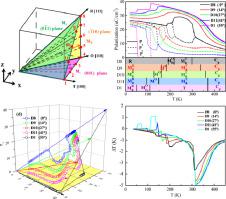当前位置:
X-MOL 学术
›
Acta Mater.
›
论文详情
Our official English website, www.x-mol.net, welcomes your feedback! (Note: you will need to create a separate account there.)
Effect of electric field orientation on ferroelectric phase transition and electrocaloric effect
Acta Materialia ( IF 9.4 ) Pub Date : 2020-06-01 , DOI: 10.1016/j.actamat.2020.03.020 Zhonghua Li , Jianting Li , Hong-Hui Wu , Junjie Li , Shihan Wang , Shiqiang Qin , Yanjing Su , Lijie Qiao , Dong Guo , Yang Bai
Acta Materialia ( IF 9.4 ) Pub Date : 2020-06-01 , DOI: 10.1016/j.actamat.2020.03.020 Zhonghua Li , Jianting Li , Hong-Hui Wu , Junjie Li , Shihan Wang , Shiqiang Qin , Yanjing Su , Lijie Qiao , Dong Guo , Yang Bai

|
Abstract The influence of electric field orientation on phase transitions and electrocaloric effects (ECEs) in BaTiO3 single crystals is studied by performing molecular dynamics simulation of first-principles-based effective Hamiltonian. The ECE is directly characterized via the adiabatic temperature change (ΔT) under the microcanonical ensemble. The simulation results demonstrate that different orientation relationship between the electric field and the polarization direction of ferroelectric phase leads to abundant phase structures and ECE behaviors. The electric-field-induced phase transitions produce remarkable ECE peaks/valleys, whereas the polarization rotation and/or extension without phase transition induced by the electric field produces small positive ECEs, which are insensitive to temperature and electric field direction. For the tetragonal-cubic phase transition, ECEs are always positive regardless of the applied electric field direction, and the value and width of ECE peak both increase with the reduction of the angle between electric field and crystallographic orientation. For the orthorhombic-tetragonal and rhombohedral-orthorhombic phase transitions, the sign of ECE gradually changes from negative to positive during the field direction rotates in planes between crystallographic orientations, and the coexistence of positive and negative appears when the field along non-crystallographic directions. Our simulated results shed light on a comprehensive physical understanding of the electric-field-orientation dependent ECE and offer instruction for the design of the refrigeration cycle by combining positive and negative ECEs.
中文翻译:

电场取向对铁电相变和电热效应的影响
摘要 通过基于第一性原理的有效哈密顿量的分子动力学模拟,研究了电场取向对 BaTiO3 单晶相变和电热效应 (ECE) 的影响。ECE 通过微正则系综下的绝热温度变化 (ΔT) 直接表征。模拟结果表明,电场与铁电相极化方向的不同取向关系导致丰富的相结构和 ECE 行为。电场引起的相变产生显着的 ECE 峰/谷,而没有由电场引起的相变的极化旋转和/或延伸产生小的正 ECE,其对温度和电场方向不敏感。对于四方-立方相变,无论施加的电场方向如何,ECE始终为正,并且ECE峰的值和宽度都随着电场与晶体取向之间夹角的减小而增加。对于正交-四方相和菱面体-正交相变,在场方向在晶向之间的平面内旋转时,ECE的符号逐渐由负变为正,当场沿非晶方向时出现正负共存。我们的模拟结果阐明了对依赖于电场方向的 ECE 的全面物理理解,并通过结合正负 ECE 为制冷循环的设计提供指导。无论施加的电场方向如何,ECE 始终为正值,并且 ECE 峰的值和宽度都随着电场与晶体取向之间夹角的减小而增加。对于正交-四方相和菱面体-正交相变,在场方向在晶向之间的平面内旋转时,ECE的符号逐渐由负变为正,当场沿非晶方向时出现正负共存。我们的模拟结果阐明了对依赖于电场方向的 ECE 的全面物理理解,并通过结合正负 ECE 为制冷循环的设计提供指导。无论施加的电场方向如何,ECE 始终为正值,并且 ECE 峰的值和宽度都随着电场与晶体取向之间夹角的减小而增加。对于正交-四方相和菱面体-正交相变,在场方向在晶向之间的平面内旋转时,ECE的符号逐渐由负变为正,当场沿非晶方向时出现正负共存。我们的模拟结果阐明了对依赖于电场方向的 ECE 的全面物理理解,并通过结合正负 ECE 为制冷循环的设计提供指导。ECE峰的值和宽度都随着电场与晶体取向夹角的减小而增加。对于正交-四方相和菱形-正交相变,ECE的符号在场方向在晶向之间的平面内旋转时逐渐由负变为正,当场沿非晶方向时出现正负共存。我们的模拟结果阐明了对依赖于电场方向的 ECE 的全面物理理解,并通过结合正负 ECE 为制冷循环的设计提供指导。ECE峰的值和宽度都随着电场与晶体取向夹角的减小而增加。对于正交-四方相和菱面体-正交相变,在场方向在晶向之间的平面内旋转时,ECE的符号逐渐由负变为正,当场沿非晶方向时出现正负共存。我们的模拟结果阐明了对依赖于电场方向的 ECE 的全面物理理解,并通过结合正负 ECE 为制冷循环的设计提供指导。对于正交-四方相和菱面体-正交相变,在场方向在晶向之间的平面内旋转时,ECE的符号逐渐由负变为正,当场沿非晶方向时出现正负共存。我们的模拟结果阐明了对依赖于电场方向的 ECE 的全面物理理解,并通过结合正负 ECE 为制冷循环的设计提供指导。对于正交-四方相和菱面体-正交相变,在场方向在晶向之间的平面内旋转时,ECE的符号逐渐由负变为正,当场沿非晶方向时出现正负共存。我们的模拟结果阐明了对依赖于电场方向的 ECE 的全面物理理解,并通过结合正负 ECE 为制冷循环的设计提供指导。
更新日期:2020-06-01
中文翻译:

电场取向对铁电相变和电热效应的影响
摘要 通过基于第一性原理的有效哈密顿量的分子动力学模拟,研究了电场取向对 BaTiO3 单晶相变和电热效应 (ECE) 的影响。ECE 通过微正则系综下的绝热温度变化 (ΔT) 直接表征。模拟结果表明,电场与铁电相极化方向的不同取向关系导致丰富的相结构和 ECE 行为。电场引起的相变产生显着的 ECE 峰/谷,而没有由电场引起的相变的极化旋转和/或延伸产生小的正 ECE,其对温度和电场方向不敏感。对于四方-立方相变,无论施加的电场方向如何,ECE始终为正,并且ECE峰的值和宽度都随着电场与晶体取向之间夹角的减小而增加。对于正交-四方相和菱面体-正交相变,在场方向在晶向之间的平面内旋转时,ECE的符号逐渐由负变为正,当场沿非晶方向时出现正负共存。我们的模拟结果阐明了对依赖于电场方向的 ECE 的全面物理理解,并通过结合正负 ECE 为制冷循环的设计提供指导。无论施加的电场方向如何,ECE 始终为正值,并且 ECE 峰的值和宽度都随着电场与晶体取向之间夹角的减小而增加。对于正交-四方相和菱面体-正交相变,在场方向在晶向之间的平面内旋转时,ECE的符号逐渐由负变为正,当场沿非晶方向时出现正负共存。我们的模拟结果阐明了对依赖于电场方向的 ECE 的全面物理理解,并通过结合正负 ECE 为制冷循环的设计提供指导。无论施加的电场方向如何,ECE 始终为正值,并且 ECE 峰的值和宽度都随着电场与晶体取向之间夹角的减小而增加。对于正交-四方相和菱面体-正交相变,在场方向在晶向之间的平面内旋转时,ECE的符号逐渐由负变为正,当场沿非晶方向时出现正负共存。我们的模拟结果阐明了对依赖于电场方向的 ECE 的全面物理理解,并通过结合正负 ECE 为制冷循环的设计提供指导。ECE峰的值和宽度都随着电场与晶体取向夹角的减小而增加。对于正交-四方相和菱形-正交相变,ECE的符号在场方向在晶向之间的平面内旋转时逐渐由负变为正,当场沿非晶方向时出现正负共存。我们的模拟结果阐明了对依赖于电场方向的 ECE 的全面物理理解,并通过结合正负 ECE 为制冷循环的设计提供指导。ECE峰的值和宽度都随着电场与晶体取向夹角的减小而增加。对于正交-四方相和菱面体-正交相变,在场方向在晶向之间的平面内旋转时,ECE的符号逐渐由负变为正,当场沿非晶方向时出现正负共存。我们的模拟结果阐明了对依赖于电场方向的 ECE 的全面物理理解,并通过结合正负 ECE 为制冷循环的设计提供指导。对于正交-四方相和菱面体-正交相变,在场方向在晶向之间的平面内旋转时,ECE的符号逐渐由负变为正,当场沿非晶方向时出现正负共存。我们的模拟结果阐明了对依赖于电场方向的 ECE 的全面物理理解,并通过结合正负 ECE 为制冷循环的设计提供指导。对于正交-四方相和菱面体-正交相变,在场方向在晶向之间的平面内旋转时,ECE的符号逐渐由负变为正,当场沿非晶方向时出现正负共存。我们的模拟结果阐明了对依赖于电场方向的 ECE 的全面物理理解,并通过结合正负 ECE 为制冷循环的设计提供指导。


























 京公网安备 11010802027423号
京公网安备 11010802027423号